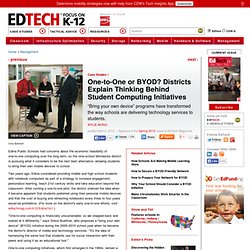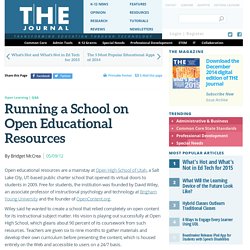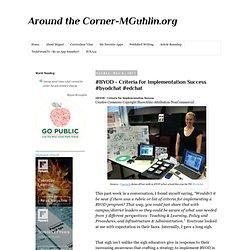

- Looking to create a social media or BYOD policy? Look no further. BYOL vs BYOD. I’m a big fan of BYOL – Bring Your Own Laptop to school.

The laptop is the new pencil… a tool necessary for an effective education today. I also think that a district-provided laptop, in public education, is not financially feasible. However, supporting families that can not afford to send their child to school with a laptop is supportable, effective and essential to a BYOL program. When I wrote the (intentionally oversimplified) ‘5 Year Technology Plan‘, my emphasis was on infrastructure: Keeping a year ahead (not 5 years ahead) with your network, providing opportunities for teachers to get learning/technical support, and making sure that students have access to the infrastructure.
The best way to provide students with opportunities to take advantage of a well-planned infrastructure is to put laptops in their hands… or more specifically, to have them bring those laptops to school. Why BYOL and not BYOD – Bring Your Own Device? Don’t get me wrong, the iPad is a great tool. One-to-One or BYOD? Districts Explain Thinking Behind Student Computing Initiatives. Edina Public Schools had concerns about the economic feasibility of one-to-one computing over the long term, so the nine-school Minnesota district is pursuing what it considers to be the next best alternative: allowing students to bring their own mobile devices to school.

Two years ago, Edina considered providing middle and high school students with notebook computers as part of a strategy to increase engagement, personalize learning, teach 21st century skills and take education beyond the classroom. After running a one-to-one pilot, the district shelved the idea when it became apparent that students preferred using their personal mobile devices and that the cost of buying and refreshing notebooks every three to four years would be prohibitive.
(For more on the district's early one-to-one efforts, visit edtechmag.com/k12/Edina1to1.) "Right now, what's driving the BYOD movement is a clear move toward digital content as opposed to print content," Rust explains. Running a School on Open Educational Resources. Open Learning | Q&A Running a School on Open Educational Resources By Bridget McCrea05/09/12 Open educational resources are a mainstay at Open High School of Utah, a Salt Lake City, UT-based public charter school that opened its virtual doors to students in 2009.

Free for students, the institution was founded by David Wiley, an associate professor of instructional psychology and technology at Brigham Young University and the founder of OpenContent.org. Wiley said he wanted to create a school that relied completely on open content for its instructional subject matter. Being one of the first high schools in the nation to rely almost entirely on open resources has been both challenging and rewarding for the staff at Open High School.
Bridget McCrea: You were last interviewed for THE Journal in 2010, roughly one year after opening the school. DeLaina Tonks: We have grown quite a bit since then. McCrea: How much of the content is open at this point? McCrea: How is the content developed? #BYOD - Criteria for Implementation Success #byodchat #edchat. #BYOD - Criteria for Implementation SuccessCreative Commons Copyright ShareAlike-Attribution-NonCommercial This past week in a conversation, I found myself saying, “Wouldn’t it be neat if there was a rubric or list of criteria for implementing a BYOD program?

That way, you could just share that with campus/district leaders so they could be aware of what was needed from 3 different perspectives: Teaching & Learning, Policy and Procedures, and Infrastructure & Administration.” Everyone looked at me with expectation in their faces. Internally, I gave a long sigh. That sigh isn’t unlike the sigh educators give in response to their increasing awareness that crafting a strategy to implement BYOD is important given the following statistics: In light of the facts above, it’s obvious that BYOD is an initiative whose time has come...and, in spite of fears--such as inappropriate social media usage by teachers and students--that may derail it: So, how do schools “get ready” to implement BYOD?
I. II.